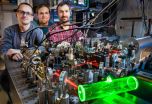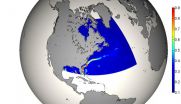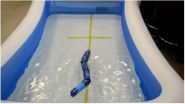Bioengineering study finds two-cell mouse embryos already talking about their future
2014-11-26
(Press-News.org) Bioengineers at the University of California, San Diego have discovered that mouse embryos are contemplating their cellular fates in the earliest stages after fertilization when the embryo has only two to four cells, a discovery that could upend the scientific consensus about when embryonic cells begin differentiating into cell types. Their research, which used single-cell RNA sequencing to look at every gene in the mouse genome, was published recently in the journal Genome Research. In addition, this group published a paper on analysis of "time-course"single-cell data which is taken at precise stages of embryonic development in the journal of Proceedings of the National Academy of Sciences.
"Until recently, we haven't had the technology to look at cells this closely," said Sheng Zhong, a bioengineering professor at UC San Diego Jacobs School of Engineering, who led the research. "Using single-cell RNA-sequencing, we were able to measure every gene in the mouse genome at multiple stages of development to find differences in gene expression at precise stages."
The findings reveal cellular activity that could provide insight into where normal developmental processes break down, leading to early miscarriages and birth defects.
The researchers discovered that a handful of genes are clearly signaling to each other at the two-cell and four-cell stage, which happens within days after an egg has been fertilized by sperm and before the embryo has implanted into the uterus. Among the identified genes are several genes belonging to the WNT signaling pathway, well-known for their role in cell-cell communications.
The prevailing view until now has been that mammalian embryos start differentiating into cell types after they have proliferated into large enough numbers to form subgroups. According to the co-authors Fernando Biase and Xiaoyi Cao, when the first cell fate decision is made is an open question. The first major task for an embryo is to decide which cells will begin forming the fetus, and which will form the placenta.
The research was funded by the National Institutes of Health (DP2OD007417) and the March of Dimes Foundation. The publications are "Cell fate inclination within 2-cell and 4-cell mouse embryos revealed by single-cell RNA sequencing", Genome Research, November 2014 and "Time-variant clustering model for understanding cell fate decisions", PNAS, November 2014.
Zhong's research in the field of systems or network biology applies engineering principals to understand how biological systems function. For example, they developed analytical methods to predict personal phenotypes, which refer to the physical description of an individual ranging from eye and hair color to health and disposition, using an individual's personal genome and epigenome. Epigenome refers to the chemical compounds in DNA that regulate gene expression and vary from person to person. Predicting phenotypes with genome and epigenome is an emerging area of research in the field of personalized medicine that scientists believe could provide new ways to predict and treat genetic disorders.
INFORMATION:
[Attachments] See images for this press release:


ELSE PRESS RELEASES FROM THIS DATE:
2014-11-26
Latest research on the oldest surviving rock art of Southeast Asia shows that the region's first people, hunter-gatherers who arrived over 50,000 years ago, brought with them a rich art practice.
Published this week in the archaeological journal Antiquity, the research shows that these earliest people skilfully produced paintings of animals in rock shelters from southwest China to Indonesia. Besides these countries, early sites were also recorded in Thailand, Cambodia and Malaysia.
Griffith University Chair in Rock Art Professor Paul Taçon led the research which ...
2014-11-26
A Brigham and Women's Hospital-led team has identified a long sought-after partner for a key immune protein, called TIM-3, that helps explain its two-faced role in the immune system -- sometimes dampening it, other times stimulating it. This newly identified partner not only sheds light on the inner workings of the immune system in diseases such as HIV, autoimmunity, and cancer, but also provides a critical path toward the development of novel treatments that target TIM-3. The researcher's findings appeared last month in the journal Nature.
"There has been a lot of confusion ...
2014-11-26
Conservationists are always looking for ways to halt the pace of deforestation in tropical rainforests. One approach involves recultivating abandoned agricultural land. An international team* investigating this concept has just published its findings in Nature Communications. Working in the mountainous regions of Ecuador, the researchers found afforestation and intense pasturing to be particularly effective, clearly increasing the environmental and economic value of abandoned farmlands.
Every year, 130,000 square kilometers of rainforest disappear from the face of the ...
2014-11-26
This news release is available in German.
A drunken sailor staggers onto a square with lots of streetlamps on it. Sometimes he will run into one of the lamps, change his direction and keep moving. Does the time he spends on this square depend on the number of streetlamps? The surprising answer is: no.
No matter whether there is a streetlamp on every square meter or whether the distance between the lamps is large: on average, the drunken sailor will always spend the same amount of time on the square. Calculations at the Vienna University of Technology (TU Wien) ...
2014-11-26
Neither quantum computers nor quantum cryptography will become prevalent technologies without memory systems able to manipulate quantum information easily and effectively. The Faculty of Physics at the University of Warsaw has recently made inroads into popularizing quantum information technologies by creating an atomic memory with outstanding parameters and an extremely simple construction.
Following years of tests in physics laboratories, the first quantum technologies are slowly emerging into wider applications. One example is quantum cryptography - an encryption ...
2014-11-26
The ocean is undergoing global changes at a remarkable pace and we must change with it to attain our best possible future ocean, warns the head of The University of Western Australia's Oceans Institute.
One of the global leaders in ocean science, Professor Carlos Duarte has shared his insights on the future of the world's oceans in a paper published in the international open-access journal Frontiers in Marine Science.
In the paper Professor Duarte explains the grand challenge researchers face in addressing global change and the future state of the ocean.
"The ocean ...
2014-11-26
This news release is available in German. Just four months after the final data package from the GOCE satellite mission was delivered, researchers are laying out a rich harvest of scientific results, with the promise of more to come. A mission of the European Space Agency (ESA), the Gravity Field and Steady-State Ocean Circulation Explorer (GOCE) provided the most accurate measurements yet of Earth's gravitational field. The GOCE Gravity Consortium, coordinated by the Technische Universität München (TUM), produced all of the mission's data products including ...
2014-11-26
The value of a piece of chocolate cake can change. Someone who happens to be on a diet is more likely to choose a fruit dessert and judge the calorie-laden cake as unhealthy. Previous studies have shown that a specific network in the brain is active when a person must decide between various choices that vary depending on context. They emphasize the interaction between neurons in two brain areas of the prefrontal cortex - the controlling area on the front side of the brain.
Prefrontal cortex shows increased activity in all decisions
Sarah Rudorf and Todd Hare of the ...
2014-11-26
On 24 October 2014, Sweden called off the hunt for a submarine after a week-long underwater search in the Stockholm archipelago. Triggered by a reported sighting of a Russian submarine, the alleged 'invasion' had been widely anticipated by military specialists and the media.
"Our assessment is that in the inner archipelago there was a plausible foreign underwater operation," Rear Adm. Anders Grenstad commented, "But we believe that what has violated Swedish waters has left."
"Whatever was there could not have been a conventional submarine," Grenstad said, but a "craft ...
2014-11-26
This news release is available in Japanese.
The deep ocean seems so remote that it is difficult to imagine any sort of human-generated change making an impact on deep-sea life. It is even more difficult to collect or examine evidence from the deep ocean to determine what those impacts might be. Enter the barnacle; a hard, sessile creature that looks like a tiny volcano and attaches to rocks, boat bottoms, and other hard substrates, where it filters ocean water to feed on tiny organisms. The barnacle holds clues about how climate change is affecting the deep ocean. ...
LAST 30 PRESS RELEASES:
[Press-News.org] Bioengineering study finds two-cell mouse embryos already talking about their future







